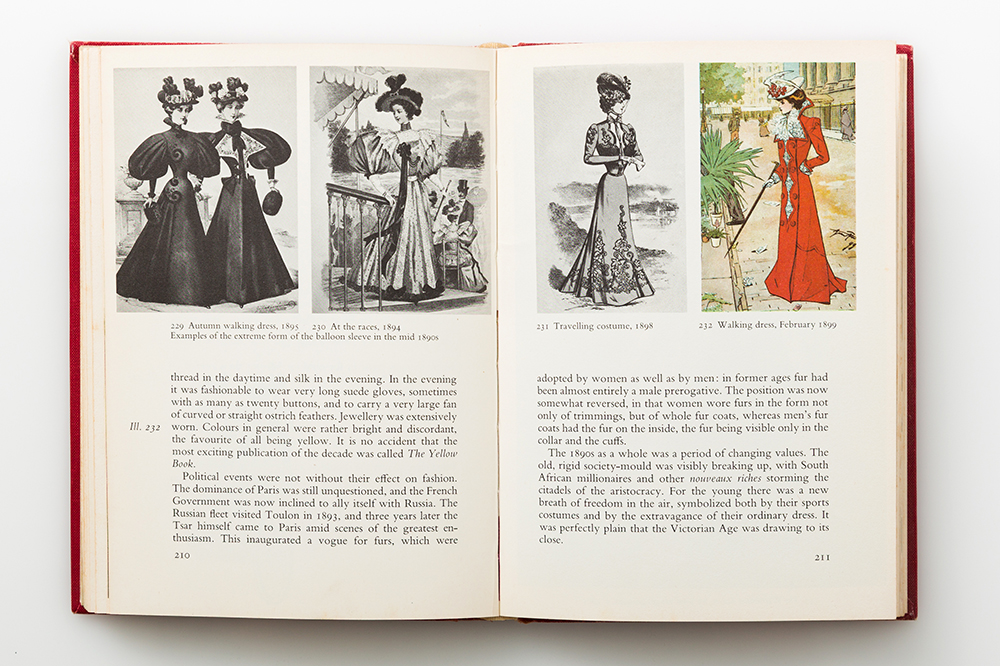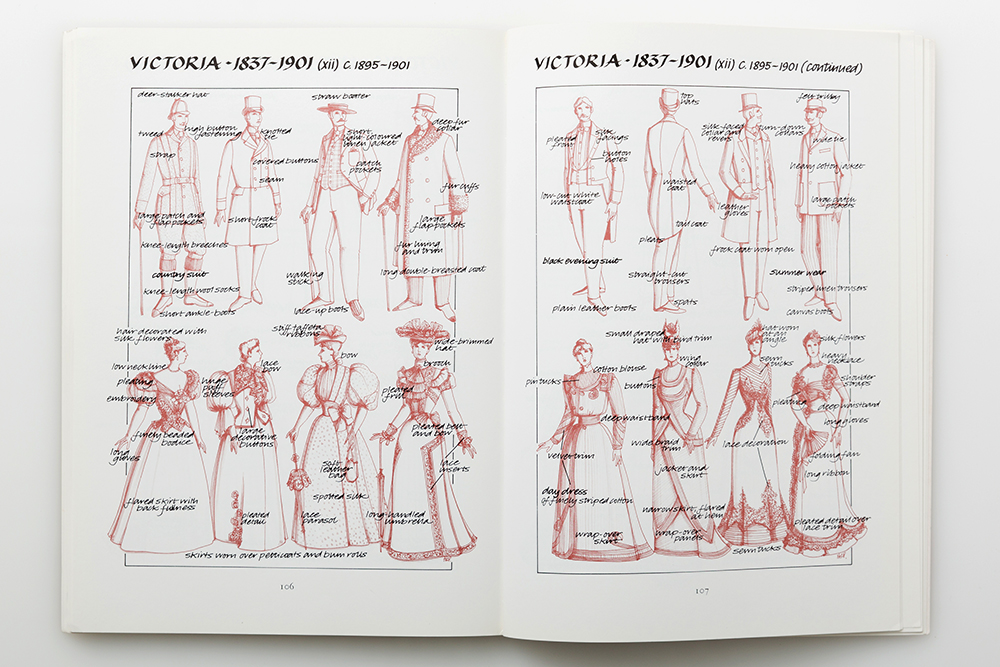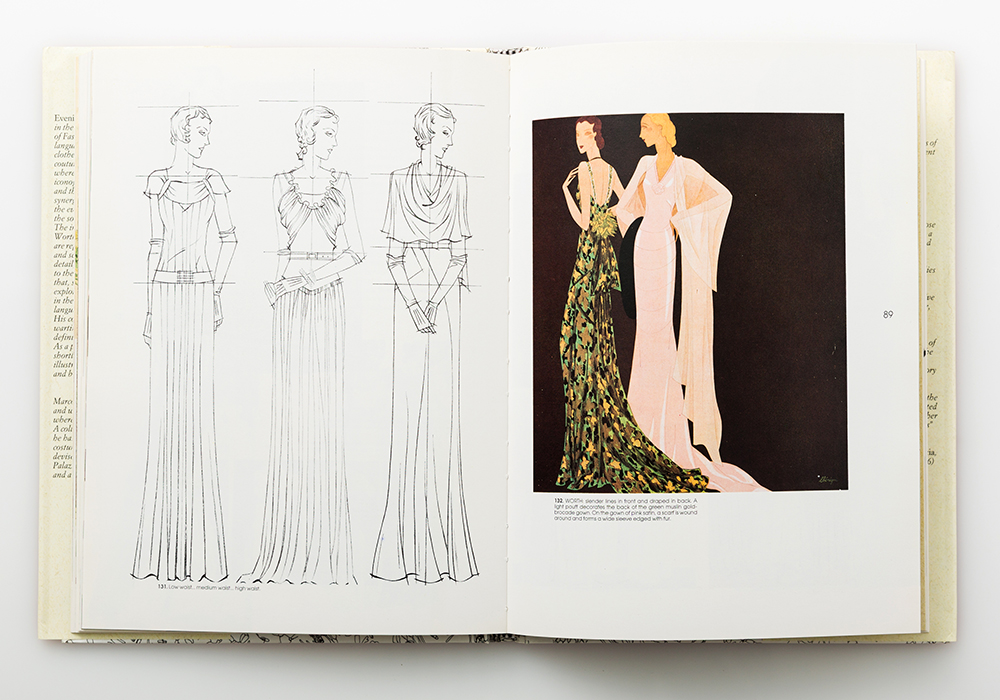What Was the Fashion Prominent Silhouette in the 2000s
Our clothing today says much well-nigh who nosotros are and—in some cases—what nosotros believe in. To some, what they wear is of not bad importance and to others, not and so much. Just modern women in most Western societies have the bureau to decide what to article of clothing and how much meaning they assign to what they vesture. In the past, what women wore presented how societies wanted them to be seen; today women can utilise fashion to project how they want to be seen. Those ideas and presentations have evolved drastically over the years. It is undoubtedly impossible to document women's style silhouettes through the years in a blog post; there are unabridged books that detail the evolution of way. Simply observing how Western and European women's garments take inverse tells us quite a flake about women—how they have changed society and how they have been changed.
Almost until the Renaissance era, earlier existence of the heart class, clothing was seen by the average man or woman equally a way to embrace their bodies. Garments were boxy and utilitarian and women probably endemic about two or 3 outfits. But slowly, the ideas of the medieval period began to fade away in favor of an historic period of awareness—of art, of science, and of beauty. Toward the end of the medieval era, wearable for women of all classes became more than colorful and amend fitted; garments of well-off women became tighter and more than form plumbing fixtures. Fabrics similar silk, linen, and fur gear up the wealthy apart from the working class. We saw the birth of tailoring and witnessed as the thought of fashion as a concept emerged. The appearance of tailor every bit an occupation showed how sectionalisation of labor was evolving.
One of the commencement truly ornamental silhouettes grew out of the years preceding the French Revolution—a time of abundance and decadence. Gowns were elaborately draped in heavy silks. At events, guild women wore panniers, which were side hoops that extended the width of the dress, while keeping the front and back relatively apartment. These extravagant garments became symbolic of widening class differences, fanning the flames of the French Revolution.

But, afterward the revolution, very few wanted to be associated with the excess of those they and then recently overthrew, and fashions became simpler and less ornamental. A high-waisted silhouette, known equally the "empire" mode, was inspired by Greco-Roman artwork and popularized by Josephine Bonaparte, wife of the French emperor. The bodice was fitted until just below the bust, when a long, gathered skirt was attached. The mode represented liberty to many women who were happy to escape heavy and uncomfortable petticoats.
The loftier-waisted fashion lasted for years, but one of the next trends saw women combining the silhouette with more than structured garments. Gauzy fabrics gave way to twills and taffeta and heavy, weighted hems replaced flowing skirts. By the 1830s, waistlines had once more dropped to simply higher up natural position. In both Europe and the United States, those with means constitute it desirable to embrace full, bong-shaped skirts and bodices laden with underpinnings. Boned stays put pressure on the waist and had gussets that pushed the bust upward. Massive "leg o'mutton" sleeves were supported with whalebone and skirts were corded or supported with heavy petticoats.

In the United states of america, women adopted the hoop-skirted way that remained pop until beyond the Civil War era. The exaggerated hip structure caused women to become walking hazards—constantly knocking over candles and gas lamps and setting their heavy dresses and wooden skirts on fire. Women could really be swept away past heavy winds and some drowned, weighted down by the hoops and stays and heavy fabrics. This is in loftier contrast to the garments assigned to enslaved women of this fourth dimension, who were dressed in clothing made from the most inexpensive cloth bachelor, ordinarily coarse, uncomfortable, and unfeminine. To strip females of their agency and identity, slave owners would oft take away any feminine apparel—dressing them in the aforementioned clothing as men and cutting off their hair. (See more about this here.)

In Europe and the US, the post-obit decades saw women'southward skirts become fifty-fifty larger and stiffer with the addition of metal hoops and crinolines. During the Victorian era, silhouettes remained tightly fitted and skirts became even more voluminous. Bustled silhouettes with back-heavy petticoats put even more emphasis on waistlines. Boned bodices were creating the newest popular shape, emphasizing the rear. Though corsets and trunk braces had been around for quote some time, women were now pushing their physical limits to an extreme to create the desired shape. Some attempted to slim their waists to the platonic 16 inches—and some fifty-fifty smaller. Of course, this style did not come without a price. Repeated years of corset wearing resulted in broken ribs and shattered ribcages, damaged and herniated organs, or suffocation. Toward the finish of the Victorian Era, women reformers began to openly oppose these body-modifying garments. The Rational Dress Club was founded to oppose fashion that "deforms the figure, impedes the movements of the body, or in whatsoever style tends to injure the wellness." Nevertheless, the hourglass silhouette is now an iconic visual representation of this era.
By the plow of the century, the Due south-Curve corset (considered a "healthy" corset, as it removed significant pressure from the abdomen) became pop. It pushed the hips astern and the chest forward. Separates became popular, as detached skirts assisted women in creating this dove-like silhouette. But, things were about to change drastically as World War I began—and women were forced to adopt more applied wearable, including (gasp) trousers.

By the 1920s, women's manner had undergone a drastic evolution. Short skirts were en vogue and androgynous looks became more than popular. The flapper, with her dropped waistlines, human knee-length skirts, and colorful garters, is symbolic of the "Roaring 20s" era. Rayon fabric, created equally a more than affordable, bogus silk, allowed more women access to the silk-stocking look. More women were inbound the workplace—or simply wanted a less fussy wardrobe—and then metallic hooks and eyes, buttons, and zippers were substituted in place of lacings and corsets. The runways displayed luxurious, loftier-cease designs that were adjusted or copied by department stores using more than affordable materials. All of these new developments were effectively democratizing style.
In the 1930s, many women wanted a highly feminine, glamorous look. Parisian designers introduced the bias-cut evening gown, meant to skim forth the trunk's curves. The boilerplate American woman' wardrobe was profoundly affected past the Great Depression—simply Hollywood promoted this glamorous trend equally an escape of sorts. They would embody everything that the everyday woman wanted but could non attain.
Rationing due to World War Ii also placed limits on the average woman'southward clothing budget. Dresses became slimmer in order to conserve cloth and separates became pop as a way to make a greater number of looks from fewer items of clothing. The expect of the military compatible influenced women'southward article of clothing and practical garments became essential as more women entered the workplace. For those who went to work in factories during the state of war, adornments were hazardous; practical, basic clothing would not get caught in heavy machinery. In an effort to preclude looking entirely masculine, women adopted high-waisted pants—like those popularized past Katharine Hepburn.

In the days immediately following the war, women were eager to comprehend feminine fashions once more. Young people's income was higher, at present that the war was over and many designers focused on youth. Fuller skirts came into mode once more, though the lengths remained shorter than in previous decades. The pencil-skirt silhouette also became pop—and girdles were wardrobe staples that helped women attain a "wasp waist" without a corset. By the 1960s, the girdle had largely been replaced by panty hose—and "control top" pantyhose for those who wanted a more than secure garment.
During the 1960s, women'southward way trends were influenced a great bargain past social movements. Many women wanted to be a fashion-forward mix of contained and traditional—like First Lady Jacqueline Kennedy. The Modern style—sleek, with assuming colors and patterns, emboldened women to clothing less with more conviction. Hippie fashion placed more importance on comfort and less importance on expensive fashions; it was fashionable to embrace non-Western cultures in manner and ideology and practice less with more.
From that moment on, many women's fashion trends grew from the ideas of the Women'south Liberation motion and the cultural norm of women in the workplace. Diane Von Furstenberg'due south wrap apparel was a staple for women who needed versatility. Women seeking equality at work sometimes embraced the "power arrange", with a masculine edge and big shoulder pads. As women's earning potential rose, then did the rejection of Hippie styles in favor of powerful, dramatic looks inspired by the decadence of boob tube shows similar Dynasty. In the decades that followed, women connected to use fashion to exhibit confidence and ability. The 1980s tendency of wearing visible undergarments was a way for women to exist empowered by their femininity and sexuality. The aforementioned was truthful in the 90s, when so-called Grunge musicians like Kathleen Hanna commanded stages, sometimes wearing only slips or nightgowns.
I'm not entirely sure if the current era has whatever defining style. Perhaps nosotros are to be divers by our revolving door approach to fashion: keep producing and give us more… At the moment, 2 very different points of view are emerging in women's way: the fast manner ideology and the new maker movement. Since the 00s, fashion labels have designed more and more collections each year to go along up with a nigh-insatiable consumer ambition for relevance. But too, more and more people desire to know more about what they wear and more women want to exist involved with making their garments. We are perhaps at a crossroads where we decide if nosotros are to be divers by our style or if our fashion is to be divers past u.s.a..
Photos by Abraham Rowe of the books Costume 1066-1966, Evening Dresses 1900-1940, Historic Costumes in Pictures, Style in Item, The Concise History of Costume and Style
0 Response to "What Was the Fashion Prominent Silhouette in the 2000s"
Post a Comment